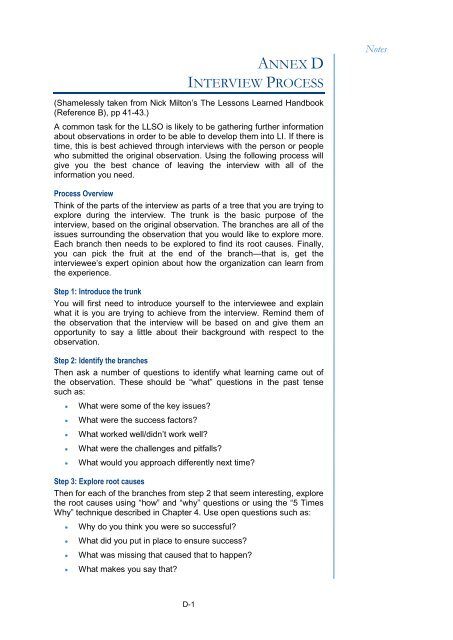JOINT ANALYSIS LESSONS LEARNED CENTRE NATO'S LEAD AGENT JOINT ANALYSIS
1ViofYb
1ViofYb
Create successful ePaper yourself
Turn your PDF publications into a flip-book with our unique Google optimized e-Paper software.
ANNEX D<br />
INTERVIEW PROCESS<br />
Notes<br />
(Shamelessly taken from Nick Milton’s The Lessons Learned Handbook<br />
(Reference B), pp 41-43.)<br />
A common task for the LLSO is likely to be gathering further information<br />
about observations in order to be able to develop them into LI. If there is<br />
time, this is best achieved through interviews with the person or people<br />
who submitted the original observation. Using the following process will<br />
give you the best chance of leaving the interview with all of the<br />
information you need.<br />
Process Overview<br />
Think of the parts of the interview as parts of a tree that you are trying to<br />
explore during the interview. The trunk is the basic purpose of the<br />
interview, based on the original observation. The branches are all of the<br />
issues surrounding the observation that you would like to explore more.<br />
Each branch then needs to be explored to find its root causes. Finally,<br />
you can pick the fruit at the end of the branch—that is, get the<br />
interviewee’s expert opinion about how the organization can learn from<br />
the experience.<br />
Step 1: Introduce the trunk<br />
You will first need to introduce yourself to the interviewee and explain<br />
what it is you are trying to achieve from the interview. Remind them of<br />
the observation that the interview will be based on and give them an<br />
opportunity to say a little about their background with respect to the<br />
observation.<br />
Step 2: Identify the branches<br />
Then ask a number of questions to identify what learning came out of<br />
the observation. These should be “what” questions in the past tense<br />
such as:<br />
<br />
<br />
<br />
<br />
<br />
What were some of the key issues?<br />
What were the success factors?<br />
What worked well/didn’t work well?<br />
What were the challenges and pitfalls?<br />
What would you approach differently next time?<br />
Step 3: Explore root causes<br />
Then for each of the branches from step 2 that seem interesting, explore<br />
the root causes using “how” and “why” questions or using the “5 Times<br />
Why” technique described in Chapter 4. Use open questions such as:<br />
<br />
<br />
<br />
<br />
Why do you think you were so successful?<br />
What did you put in place to ensure success?<br />
What was missing that caused that to happen?<br />
What makes you say that?<br />
D-1



